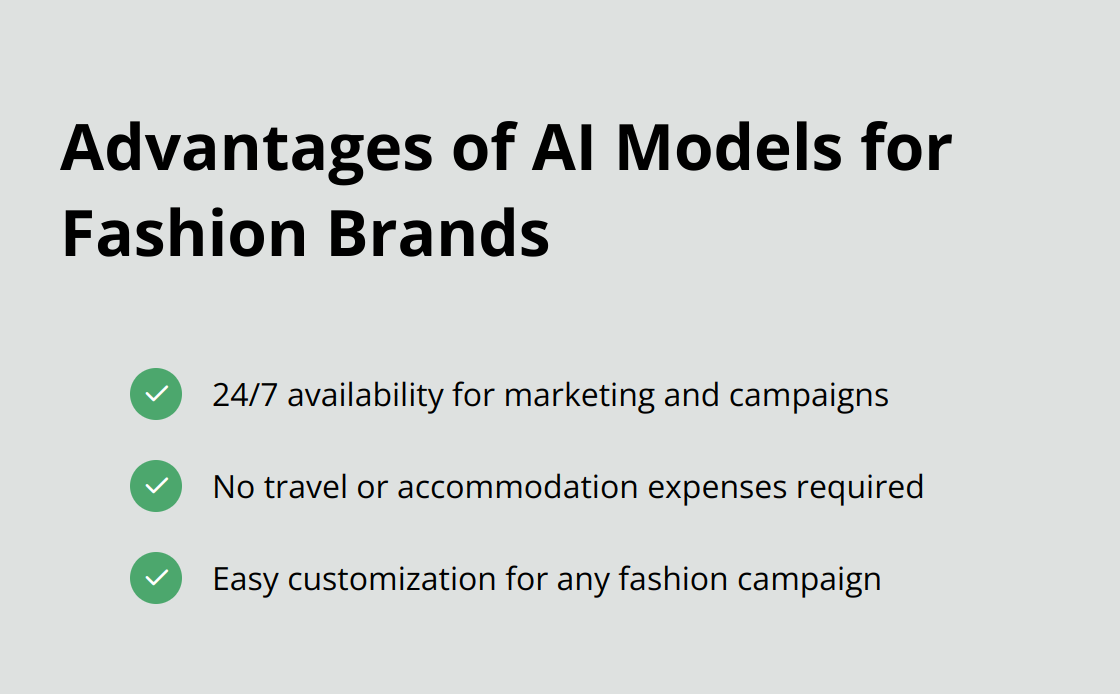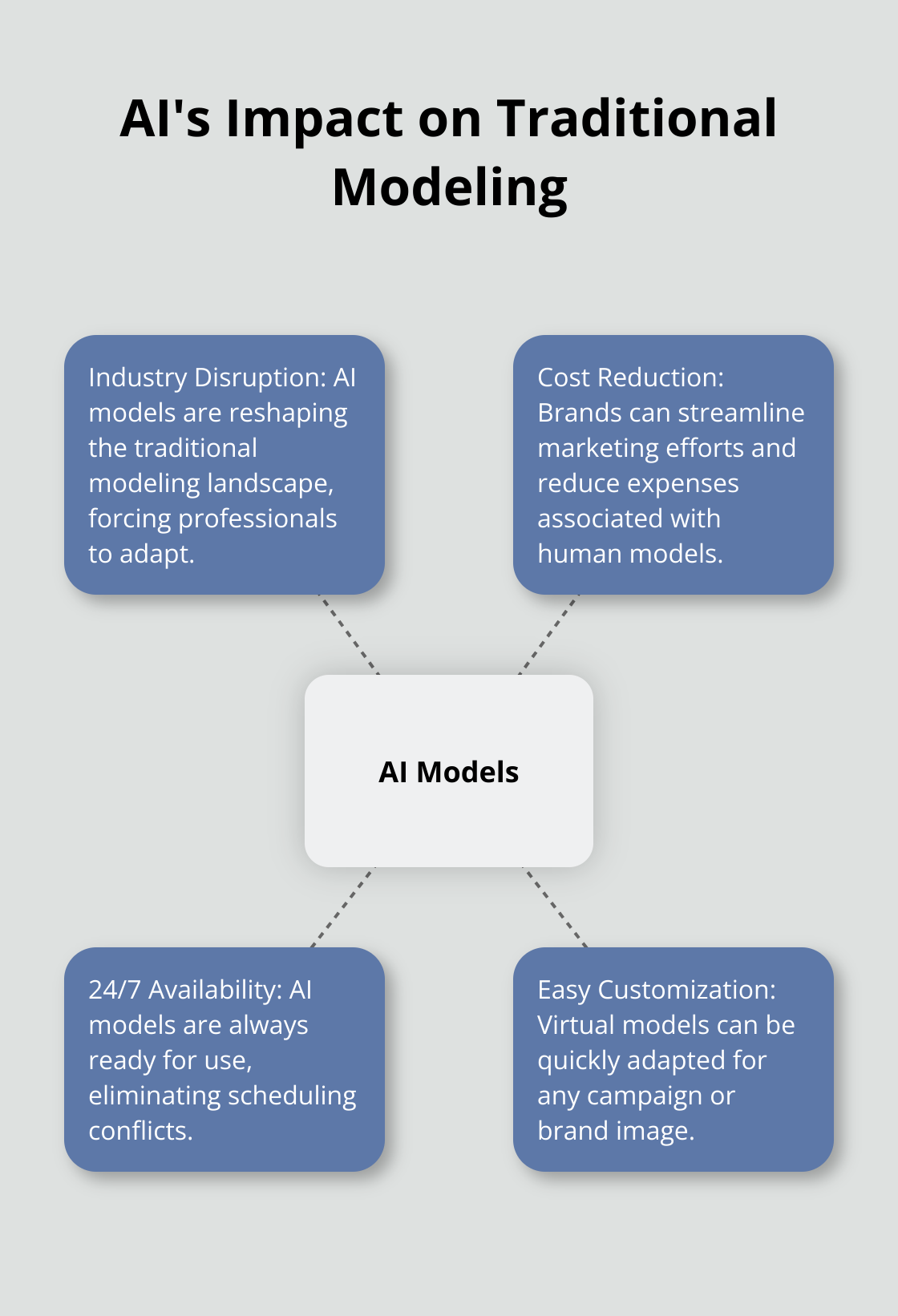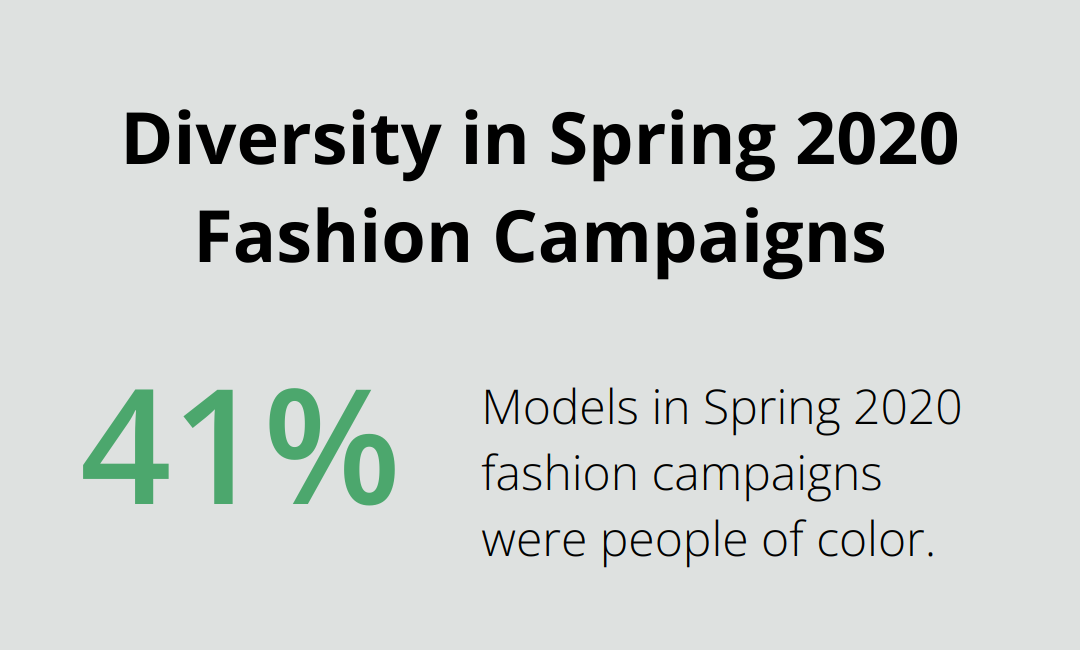At Jiu Jitsu, we’re fascinated by the intersection of technology and fashion. The rise of AI-powered virtual models is reshaping the industry, challenging traditional notions of beauty and representation.
As we explore this trend, we’ll examine the key players, ethical considerations, and potential impact on careers – including those of Giselle, our jiu jitsu instructor turned fashion model.
AI Models Reshape Fashion Industry
The Birth of Virtual Supermodels
The fashion industry faces a seismic shift with the introduction of AI-powered virtual models. These digital creations redefine the concept of a model and change how we view fashion. Brands like Gucci and Balenciaga are paving the way with fully immersive virtual flagship stores, going way beyond basic e-commerce. Since their introduction, the use of virtual models has exploded, with various luxury brands experimenting with digital avatars in their marketing.
AI’s Impact on Traditional Modeling
The rise of AI models sends shockwaves through the traditional modeling industry. This shift forces many in the industry to adapt and find new ways to stay relevant.
The Advantages of AI Models
AI models offer several benefits for brands:
- 24/7 availability
- No travel or accommodation requirements
- Easy customization for any campaign
These advantages make AI models an attractive option for fashion brands looking to streamline their marketing efforts and reduce costs.

Concerns and Challenges
Despite their benefits, AI models raise concerns about unrealistic beauty standards and the loss of human touch in fashion. Critics argue that the perfection portrayed by these digital creations may further exacerbate body image issues and contribute to unrealistic expectations in the industry.
The Human Element in Fashion
At Souza Grappling Co., we value the power of real human connection. While AI models reshape the fashion landscape, we believe there’s no substitute for authenticity and energy. Our Jiu-Jitsu classes emphasize the importance of human interaction and personal growth.
As the fashion industry continues to evolve, the question remains: who will train these digital supermodels, and what role will human expertise play in shaping their development? The next section explores the key players in AI model development and their impact on the future of fashion.
Who’s Shaping AI Fashion?
Tech Titans Lead the AI Fashion Revolution
Silicon Valley heavyweights spearhead AI model development. NVIDIA’s StyleGAN creates hyper-realistic faces, revolutionizing digital model creation. Adobe’s Sensei AI platform empowers designers to manipulate virtual models with unprecedented ease. These technological advancements (once confined to sci-fi movies) now shape the future of fashion marketing.
Fashion Brands Embrace the Digital Runway
Luxury fashion houses actively participate in the AI revolution. Balmain introduced a virtual army of models, including Shudu Gram, the world’s first digital supermodel. Created by photographer Cameron-James Wilson, Shudu has graced magazine covers and fronted campaigns for major brands. Prada experiments with CGI influencers, blurring the lines between reality and digital artistry (a trend that continues to gain momentum).
The Synergy of Silicon and Style
Tech companies and fashion brands forge powerful alliances. IBM’s AI technology assists Tommy Hilfiger in analyzing trends and customer preferences. This partnership influences not just marketing but the creative process itself. The fusion of data-driven insights and artistic vision promises to reshape the industry landscape.
AI’s Impact on Traditional Modeling
The rise of AI models disrupts the traditional modeling industry. Many professionals must adapt to stay relevant. AI models offer brands 24/7 availability, no travel requirements, and easy customization for any campaign. These advantages make AI models an attractive option for fashion brands aiming to streamline marketing efforts and reduce costs.

The Human Element in Fashion
Despite technological advancements, the fashion industry still values authentic human connections. While AI reshapes the landscape, many argue that it can’t replicate the energy and charisma of human models. The challenge lies in striking a balance between innovation and preserving the human touch that has long defined fashion.
As we explore the ethical considerations surrounding AI in fashion, we must consider how this technology impacts representation, privacy, and job security in the industry.
The Dark Side of AI Fashion
Diversity Dilemma in Digital Models
AI-generated models often perpetuate narrow beauty standards, which exacerbates representation issues in fashion. A study by the Fashion Spot revealed that only 41.5% of models in Spring 2020 fashion campaigns were people of color. AI models risk further skewing this imbalance. Tech companies must prioritize diverse datasets to create inclusive virtual models that reflect real-world diversity.

Data Privacy Concerns
The creation of AI models relies heavily on vast amounts of personal data (raising serious privacy concerns). In 2018, H&M faced a €35 million fine for illegal surveillance of employees, which highlighted the potential for misuse of personal information in the fashion industry. As AI models become more prevalent, brands must implement robust data protection measures and obtain clear consent from individuals whose likeness may be used to train these systems.
Job Market Disruption
The advent of AI models threatens traditional modeling careers. The International Labor Organization estimates that automation could displace up to 800 million jobs by 2030 (a staggering figure). While AI models offer cost-saving benefits for brands, they risk leaving human models without work. Industry leaders must consider retraining programs and new roles for displaced workers to mitigate this impact.
Ethical Considerations in AI Development
The rapid advancement of AI in fashion raises important ethical questions. Developers must address issues such as bias in algorithms, transparency in AI decision-making processes, and the potential for AI to reinforce harmful stereotypes. The fashion industry needs to establish clear guidelines and standards for the ethical use of AI in model creation and marketing.
Balancing Innovation and Human Touch
While AI reshapes the fashion landscape, many argue that it can’t replicate the energy and charisma of human models. The challenge lies in striking a balance between technological innovation and preserving the authentic human connections that have long defined fashion. Companies like Souza Grappling Co. emphasize the importance of real relationships and personal growth in their programs, showcasing the enduring value of human interaction in various industries.
Final Thoughts
AI will reshape the fashion industry, but it cannot replace the human element. The future lies in a harmonious collaboration between AI capabilities and human creativity. Fashion brands must address ethical concerns, maintain diversity, and protect data privacy as they embrace this technological revolution.
The industry faces challenges, including potential job displacement and the need to preserve authentic connections with consumers. However, new opportunities will emerge in AI model development and digital fashion design. Companies must support workers through this transition and find innovative ways to blend technology with human touch.
Giselle, our Jiu Jitsu instructor turned fashion model, exemplifies the valuable skills martial arts bring to the runway. Her journey showcases how discipline and adaptability translate across industries. We at Souza Grappling Co. believe in the power of human connection, which we foster through our Jiu-Jitsu classes (just as fashion should continue to inspire through genuine human experiences).




